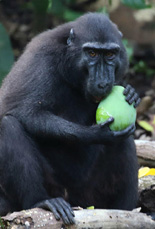|
 The Celebes Crested Macaque is an Old World monkey that lives
in the Tangkoko reserve (home of the biggest crested macaque population
remaining in the species' original distribution range) in the north-eastern
tip of the Indonesian island of Sulawesi as well as on smaller neighbouring
islands. The Celebes crested macaque is a diurnal rain forest dweller.
This macaque is primarily terrestrial, spending most of its day
on the ground foraging for food and socializing, while sleeping
and searching for food in the trees. They are frugivorous, with
most of their diet fruit, although they also eat leaves, buds, seeds,
fungus, small birds and bird eggs, insects (such as beetles and
caterpillars) worms, snails and the occasional small lizard or frog.
Locally known as yaki or wolai, its skin and hairless face is, with
the exception of some white hair in the shoulder range, entirely
jet black. Unusual for a primate, it has striking reddish-brown
eyes. The long muzzle with high cheeks and the long hair tuft, or
crest, at the top of the head are remarkable features. It has an
"apelike" appearance due to its almost non-existent, non-visible,
vestigial tail stub of only approximately 2 cm. With a total body
length of 44 cm to 60 cm and a weight of 3.6 kg to 10.4 kg, it is
one of the smaller macaque species. Its life expectancy is estimated
at approximately 15-20 years in the wild. They typically live in
groups of five to twenty-five animals, and occasionally in groups
of up to seventy-five animals. Smaller groups have only a single
adult male, while larger groups have up to four adult males. However,
adult females always outnumber adult males by about 4:1. Young adult
males are forced to leave their birth group upon maturity, sometimes
forming bachelor groups before seeking a connection to an existing
adult mixed-sex group. Communication consists of various sounds
and gestures; such as the presentation of the long canine teeth
while grimacing, a clearly threatening gesture. They are promiscuous,
with both males and females mating multiple times with multiple
partners. The receptivity of the females is clearly indicated by
an extreme tumescence (swelling) and redness of their buttocks which,
in contrast to the black skin color, is particularly noticeable.
The gestation time is 174 days, and the birth of the usually single
offspring happens in the spring when food is more plentiful. Young
animals are nursed for approximately one year, becoming fully mature
in three to four years, females somewhat sooner than males. Because
they live from crops and fields, they are hunted as a pest. They
are also hunted for the bushmeat trade. Clearing the rain forests
further threatens their survival. Their situation on the small neighbouring
islands of Sulawesi (such as Bacan) is somewhat better, since these
have a low human population. The total population of the macaque
on Sulawesi is estimated at 4,000-6,000, while a booming population
of up to 100,000 monkeys is found on Bacan.
The Celebes Crested Macaque is an Old World monkey that lives
in the Tangkoko reserve (home of the biggest crested macaque population
remaining in the species' original distribution range) in the north-eastern
tip of the Indonesian island of Sulawesi as well as on smaller neighbouring
islands. The Celebes crested macaque is a diurnal rain forest dweller.
This macaque is primarily terrestrial, spending most of its day
on the ground foraging for food and socializing, while sleeping
and searching for food in the trees. They are frugivorous, with
most of their diet fruit, although they also eat leaves, buds, seeds,
fungus, small birds and bird eggs, insects (such as beetles and
caterpillars) worms, snails and the occasional small lizard or frog.
Locally known as yaki or wolai, its skin and hairless face is, with
the exception of some white hair in the shoulder range, entirely
jet black. Unusual for a primate, it has striking reddish-brown
eyes. The long muzzle with high cheeks and the long hair tuft, or
crest, at the top of the head are remarkable features. It has an
"apelike" appearance due to its almost non-existent, non-visible,
vestigial tail stub of only approximately 2 cm. With a total body
length of 44 cm to 60 cm and a weight of 3.6 kg to 10.4 kg, it is
one of the smaller macaque species. Its life expectancy is estimated
at approximately 15-20 years in the wild. They typically live in
groups of five to twenty-five animals, and occasionally in groups
of up to seventy-five animals. Smaller groups have only a single
adult male, while larger groups have up to four adult males. However,
adult females always outnumber adult males by about 4:1. Young adult
males are forced to leave their birth group upon maturity, sometimes
forming bachelor groups before seeking a connection to an existing
adult mixed-sex group. Communication consists of various sounds
and gestures; such as the presentation of the long canine teeth
while grimacing, a clearly threatening gesture. They are promiscuous,
with both males and females mating multiple times with multiple
partners. The receptivity of the females is clearly indicated by
an extreme tumescence (swelling) and redness of their buttocks which,
in contrast to the black skin color, is particularly noticeable.
The gestation time is 174 days, and the birth of the usually single
offspring happens in the spring when food is more plentiful. Young
animals are nursed for approximately one year, becoming fully mature
in three to four years, females somewhat sooner than males. Because
they live from crops and fields, they are hunted as a pest. They
are also hunted for the bushmeat trade. Clearing the rain forests
further threatens their survival. Their situation on the small neighbouring
islands of Sulawesi (such as Bacan) is somewhat better, since these
have a low human population. The total population of the macaque
on Sulawesi is estimated at 4,000-6,000, while a booming population
of up to 100,000 monkeys is found on Bacan.
|
 Celebes
Crested Macaque -
Issue Forty-One
Celebes
Crested Macaque -
Issue Forty-One